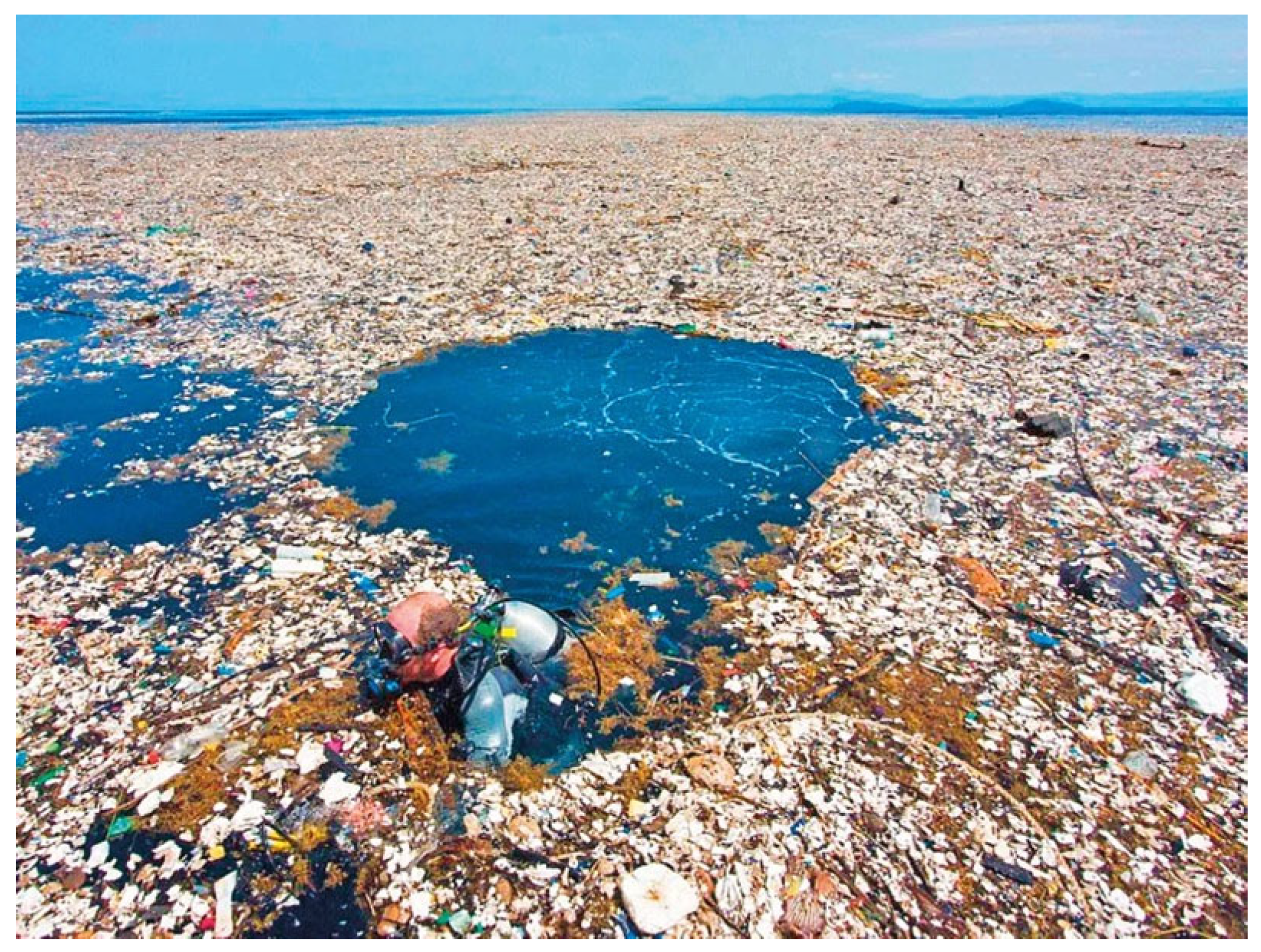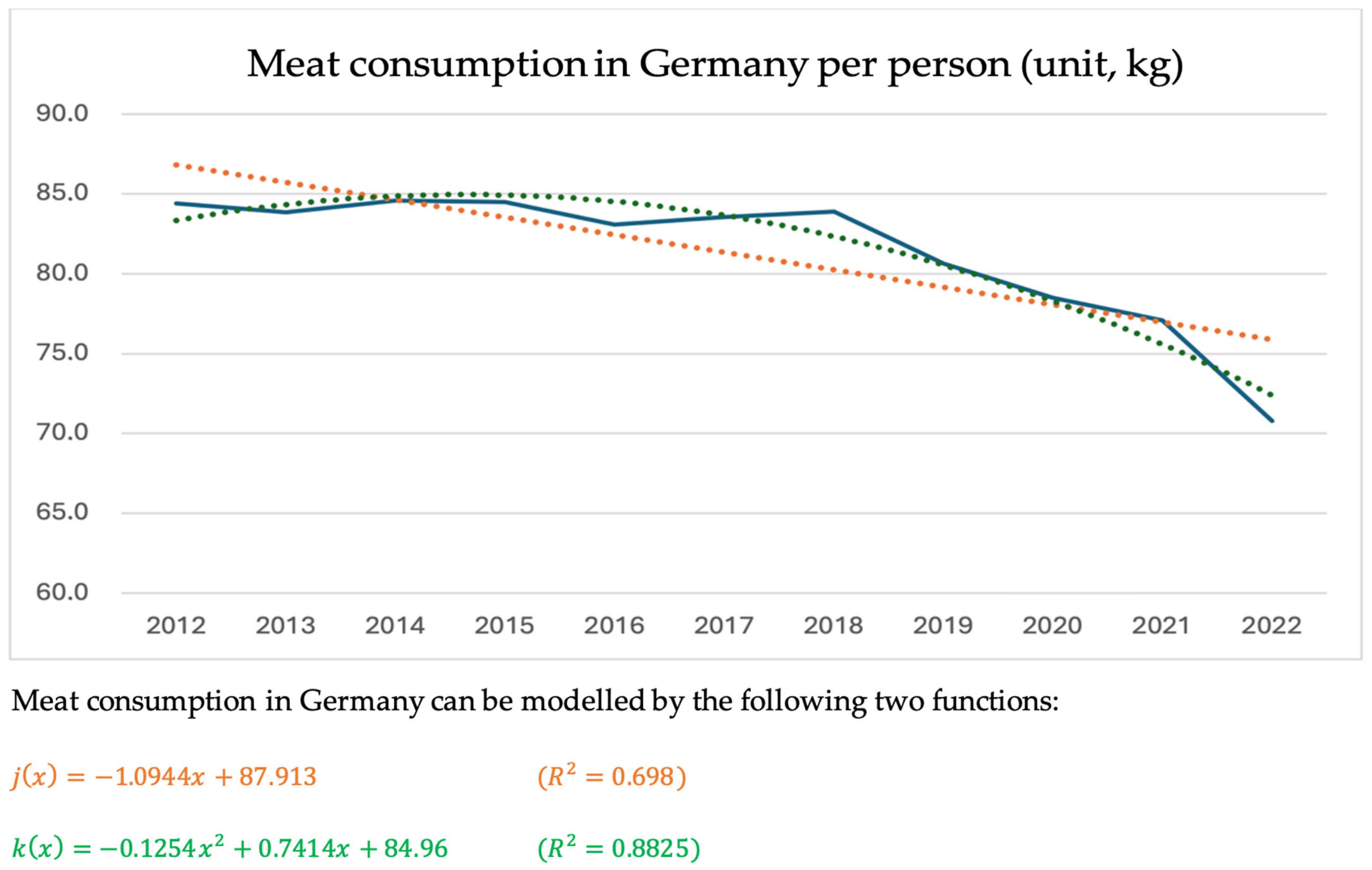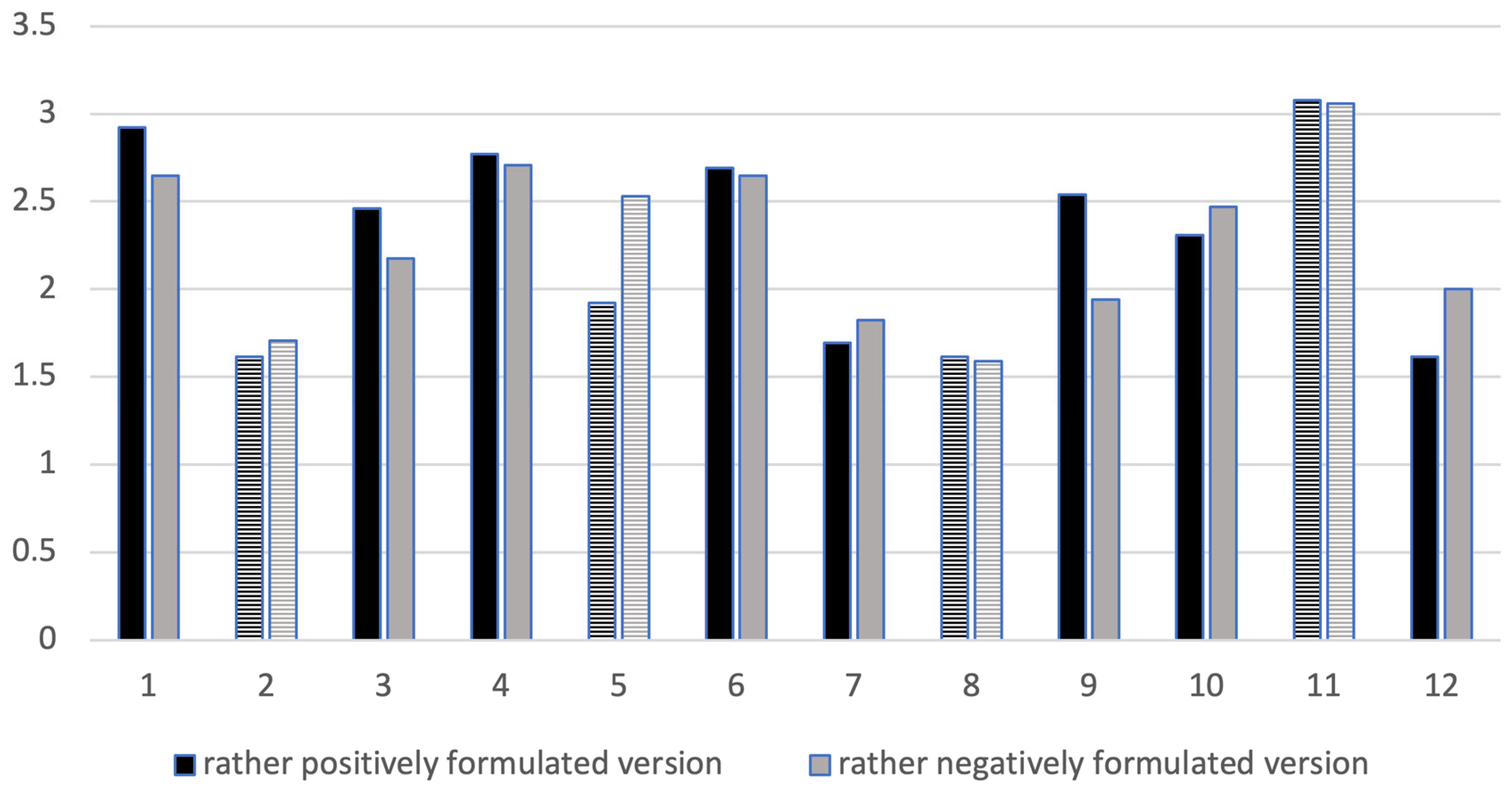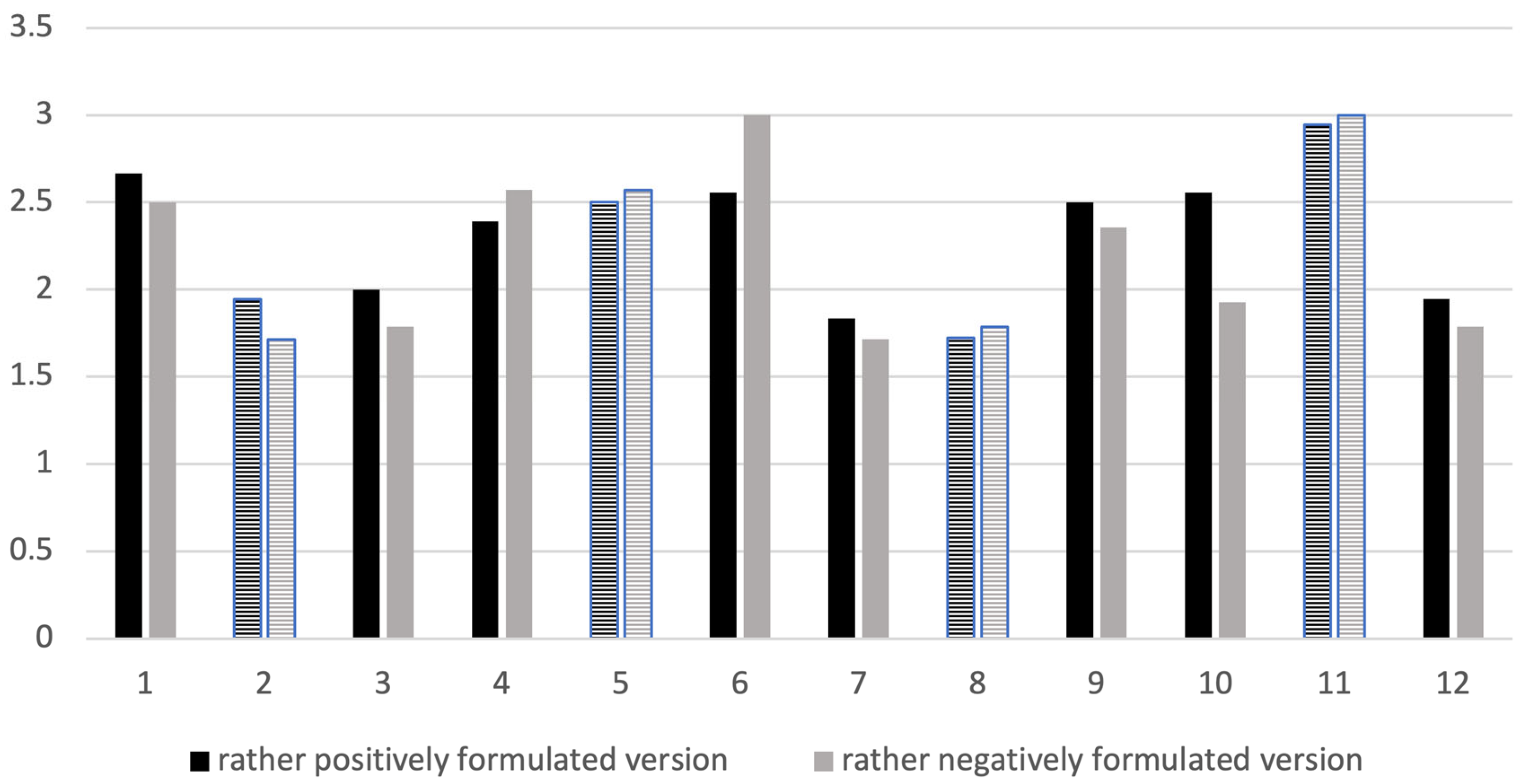The Role of Experiencing Self-Efficacy When Completing Tasks—Education for Sustainable Development in Mathematics
Abstract
1. Introduction
2. Theoretical Background
2.1. Selected Didactic Approaches for Integrating ESD into the Classroom
2.2. Self-Efficacy as a Characteristic in Mathematics Lessons
- -
- “In maths, I am confident that I can understand even the most difficult material”.
- -
- -
- “If I try hard, I can do all the maths homework” [24].
2.3. Self-Efficacy in the Context of Sustainability
2.4. Tasks on Sustainable Development in Maths Lessons
2.5. Methodological Remarks
- I am interested in what I have learned with the worksheet.
- I was bored while working on the worksheet.
- I worked on the worksheet because I enjoyed it.
- I like the fact that I was able to discover something myself while working on the worksheet.
- I wish I hadn’t had to do the worksheet.
- It was important to me to solve the worksheet, even if it had taken longer.
- I worked hard on the worksheet because I will someday need the knowledge in my job.
- I tried to do as little as possible for the worksheet.
- I am interested in exploring the topic covered in the worksheet further myself.
- I will continue to think about the topic of the worksheet after school.
- The worksheet does not play a major role in my everyday life.
- I will talk to my parents about the contents of the worksheet.
3. Results
4. Discussion and Conclusions
Author Contributions
Funding
Institutional Review Board Statement
Informed Consent Statement
Data Availability Statement
Acknowledgments
Conflicts of Interest
Appendix A. The ‘Packaging’ Worksheet


- -
- Calculate the surface area that could be covered with the plastic saved each year.
- -
- How should this problem be dealt with in Germany? Can you think of any solutions?
- -
- What other deceptive packaging do you know, or can you think of after you have been familiarized with the term?
Appendix B. The ‘Rainforest’ Worksheet



- -
- What options can you think of to deal with this problem?
- -
- How do you rate Germany in this context?
References
- Environment and Climate Change Committee. 1st Report of Session 2022–23. In Our Hands: Behaviour Change for Climate and Environmental Goals; House of Lords, Ed.; 2022. Available online: https://publications.parliament.uk/pa/ld5803/ldselect/ldenvcl/64/64.pdf (accessed on 7 April 2025).
- United Nations Climate Action. Available online: https://www.un.org/en/climatechange/reports (accessed on 7 April 2025).
- Falegnami, A.; Romano, E.; Tomassi, A. The emergence of the GreenSCENT competence framework: A constructivist approach: The GreenSCENT theory. In The European Green Deal in Education; Routledge: London, UK, 2024; pp. 204–216. [Google Scholar]
- KMK. Orientierungsrahmen für den Lernbereich Globale Entwicklung im Rahmen einer Bildung für nachhaltige Entwicklung, 2nd ed.; Cornelsen: Berlin, Germany, 2016. [Google Scholar]
- Winter, H. Sachrechnen in der Grundschule; Cornelsen: Frankfurt, Germany, 1992. [Google Scholar]
- Maitzen, C. Zusammenstellung von Beispielen, wie BNE-Inhalte im Mathematikunterricht der Sekundarstufe I Eingesetzt Werden Können. Available online: https://warmeling.de/wp-content/uploads/2023/07/Zusammenstellung-BNE-Inhalte_20230715.pdf (accessed on 7 April 2025).
- Wilhelm, K.; BNE im Mathematikunterricht. Nicht nur eine Frage der Lerninhalte. Der Achtsame Unterricht. UP: Saarland, Germany. 2024. Available online: https://publikationen.sulb.uni-saarland.de/bitstream/20.500.11880/38099/1/Dissertation_WilhelmKatharina.pdf (accessed on 7 April 2025).
- Herget, W.; Ein Bild sagt mehr als 1000 Worte. Messen, Schätzen, Überlegen–viele Wege, viele Antworten. Available online: https://disk.mathematik.uni-halle.de/lehrerseite/bild_1000_worte.pdf (accessed on 7 April 2025).
- Meyer, M. Mathe in BNE–BNE in Mathe. Spannungen in der Vernetzung zweier bedeutender Bereiche. In Beiträge zum Mathematikunterricht; Ebers, P., Rösken, F., Büchter, A., Schacht, F., Scherer, P., Eds.; WTM: Münster, Germany, 2024. [Google Scholar]
- Schwarz, A.; Niels, W.; Fuchs, T.; Schlüter, K.; Godinho, T.; Meyer, M. How much carbon is locked in that tree? Sci. Sch. 2024, 67, 1–7. Available online: https://www.scienceinschool.org/article/2024/carbon-locked-in-that-tree/ (accessed on 7 April 2025).
- Mehren, R.; Ulrich-Riedhammer, M.; Applis, S. The Future We Want. Available online: https://doinggeoandethics.com/2022/10/04/was-versteht-man-unter-loesungsorientierter-didaktik-das-erklaervideo-zum-neuen-ansatz-im-bereich-bne/#comments (accessed on 7 April 2025).
- Hoffmann, T. Lösungsorientierter Geographieunterricht. In Wörterbuch der Geographiedidaktik; Böhn, D., Obermaier, G., Eds.; Werstermann: Braunschweig, Germany, 2023; pp. 185–186. [Google Scholar]
- Bertelsmann Foundation. Krieg und Klimawandel machen den Jugendlichen in Deutschland mehr Sorgen als Corona. Available online: https://www.bertelsmann-stiftung.de/de/themen/aktuelle-meldungen/2022/august/krieg-und-klimawandel-machen-den-jugendlichen-in-deutschland-mehr-sorgen-als-corona (accessed on 7 April 2025).
- Robert Bosch Stiftung. Jeder fünfte junge Mensch berichtet von psychischen Problemen. Deutsches Schulbarometer. 2024. Available online: https://deutsches-schulportal.de/bildungswesen/deutsches-schulbarometer-schueler-2024-jeder-fuenfte-junge-mensch-berichtet-von-psychischen-problemen (accessed on 7 April 2025).
- Stoknes, P.E. What We Think About When We Try Not to Think About Global Warming; Chelsea Green Publishing: New York, NY, USA, 2015. [Google Scholar]
- Bandura, A. Exercise of personal and collective self-efficacy in changing societies. In Self-Efficacy in Changing Societies; Bandura, A., Ed.; Cambridge University Press: Cambridge, UK, 1995; pp. 1–45. [Google Scholar]
- Schukajlow, S.; Achmetli, K.; Rakoczy, K. Does constructing multiple solutions for real-world problems affect self-efficacy? Educ. Stud. Math. 2019, 100, 43–60. [Google Scholar] [CrossRef]
- Schukajlow, S.; Rakoczy, K.; Pekrun, R. Emotions and motivation in mathematics education: Where we are today and where we need to go. ZDM–Math. Educ. 2023, 55, 249–267. [Google Scholar] [CrossRef] [PubMed]
- Street, K.E.S.; Malmberg, L.-E.; Stylianides, G.J. Changes in students’ self-efficacy when learning a new topic in mathematics: A micro-longitudinal study. Educ. Stud. Math. 2022, 111, 515–541. [Google Scholar] [CrossRef]
- Zakariya, Y.F. Improving students’ mathematics self-efficacy: A systematic review of intervention studies. Front. Psychol. 2022, 13, 986622. [Google Scholar] [CrossRef] [PubMed]
- Pajares, F. Self-Efficacy Beliefs in Academic Settings. Rev. Educ. Res. 1996, 66, 543–578. [Google Scholar] [CrossRef]
- Zakariya, Y.F. Study Approaches in Higher Education Mathematics: Investigating the Statistical Behaviour of an Instrument Translated into Norwegian. Educ. Sci. 2019, 9, 191. [Google Scholar] [CrossRef]
- Yan, Z.; Arpan, L.M.; Clayton, R.B. Assessing the Role of Self-Efficacy in Reducing Psychological Reactance to Guilt Appeals Promoting Sustainable Behaviors. Sustainability 2024, 16, 7777. [Google Scholar] [CrossRef]
- Gaspard, H.; Jiang, Y.; Piesch, H.; Nagengast, B.; Jia, N.; Lee, J.; Bong, M. Assessing students’ values and costs in three countries: Gender and age differences within countries and structural differences across countries. Learn. Individ. Differ. 2020, 79, 101836. [Google Scholar] [CrossRef]
- Bandura, A. On the functional properties of perceived self-efficacy revisited. J. Manag. 2015, 38, 9–44. [Google Scholar] [CrossRef]
- Meinhold, J.L.; Malkus, A.J. Adolescent Environmental Behaviors: Can Knowledge, Attitudes, and Self-Efficacy Make a Difference? Environ. Behav. 2005, 37, 511–532. [Google Scholar] [CrossRef]
- Gaspard, H.; Brisson, B.; Häfner, I.; Dicke, A.-L.; Flunger, B.; Parrisius, C.; Nagengast, B.; Trautwein, U. Motivationsförderung im Mathematikunterricht (MoMa 1.0). Skalendokumentation Schülerfragebogen; Universität Tübingen: Tübingen, Germany, 2019. [Google Scholar]
- Siebert, H. Lernmotivation und Bildungsbeteiligung; Bertelsmann: Bielefeld, Germany, 2006. [Google Scholar] [CrossRef]
- Prenzel, M.; Krapp, A.; Schiefele, H. Grundzüge einer pädagogischen Interessentheorie. Z. Für Pädagogik 1986, 32, 163–173. [Google Scholar]
- Mang, J.; Ustjanzew, N.; Schiepe-Tiska, A.; Prenzel, M.; Sälzer, C.; Müller, K.; Gonzaléz Rodríguez, E. PISA 2012 Skalenhandbuch: Dokumentation der Erhebungsinstrumente; Waxmann: Münster, Germany, 2018. [Google Scholar]
- Rau, H.; Nicolai, S.; Franikowski, P.; Stoll-Kleemann, S. Distinguishing between Low- and High-Cost Pro-Environmental Behavior: Empirical Evidence from Two Complementary Studies. Sustainability 2024, 16, 2206. [Google Scholar] [CrossRef]
- Kammrad, C.; Meyer, M. Nachhaltigkeit und Selbstwirksamkeit im Mathematikunterricht: Ein Fragebogen zu Einstellungen von Lernenden. In Beiträge zum Mathematikunterrich; Lambert, A., Platz, M., Eds.; WTM: Münster, Germany, 2025. [Google Scholar]


Disclaimer/Publisher’s Note: The statements, opinions and data contained in all publications are solely those of the individual author(s) and contributor(s) and not of MDPI and/or the editor(s). MDPI and/or the editor(s) disclaim responsibility for any injury to people or property resulting from any ideas, methods, instructions or products referred to in the content. |
© 2025 by the authors. Licensee MDPI, Basel, Switzerland. This article is an open access article distributed under the terms and conditions of the Creative Commons Attribution (CC BY) license (https://creativecommons.org/licenses/by/4.0/).
Share and Cite
Meyer, M.; Kammrad, C.; Esser, R. The Role of Experiencing Self-Efficacy When Completing Tasks—Education for Sustainable Development in Mathematics. Sustainability 2025, 17, 4298. https://doi.org/10.3390/su17104298
Meyer M, Kammrad C, Esser R. The Role of Experiencing Self-Efficacy When Completing Tasks—Education for Sustainable Development in Mathematics. Sustainability. 2025; 17(10):4298. https://doi.org/10.3390/su17104298
Chicago/Turabian StyleMeyer, Michael, Carolin Kammrad, and Ruben Esser. 2025. "The Role of Experiencing Self-Efficacy When Completing Tasks—Education for Sustainable Development in Mathematics" Sustainability 17, no. 10: 4298. https://doi.org/10.3390/su17104298
APA StyleMeyer, M., Kammrad, C., & Esser, R. (2025). The Role of Experiencing Self-Efficacy When Completing Tasks—Education for Sustainable Development in Mathematics. Sustainability, 17(10), 4298. https://doi.org/10.3390/su17104298






